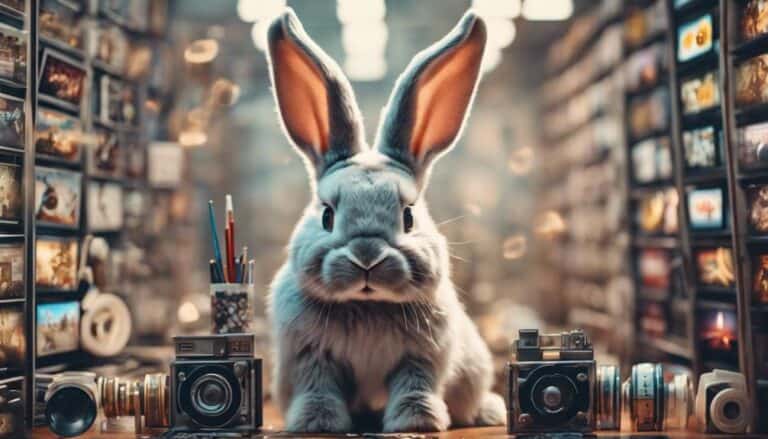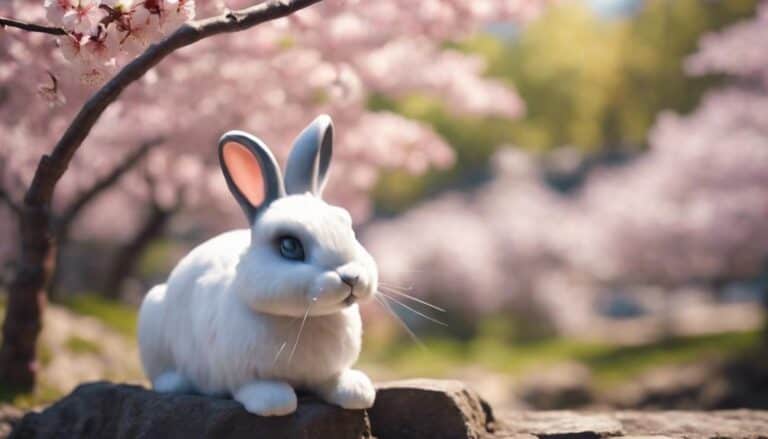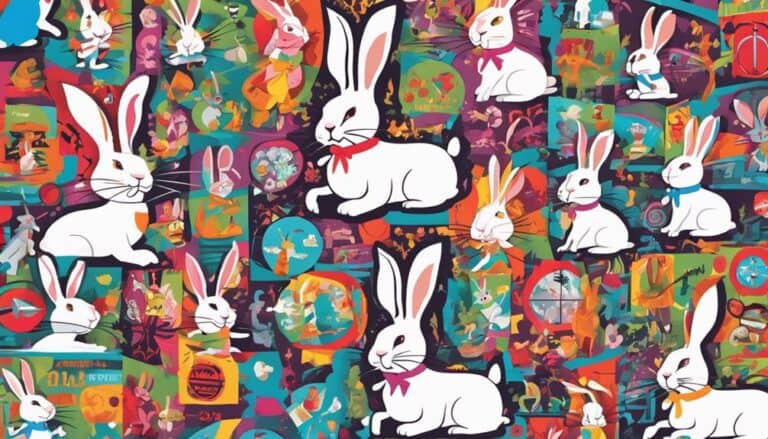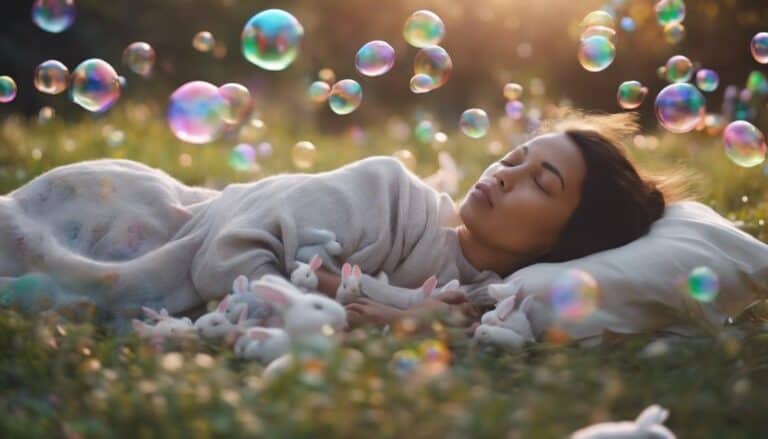In Salvador Dali's surrealist painting 'Dream Caused by the Flight of a Bee Around a Pomegranate a Second Before Awakening,' a rabbit is depicted symbolizing the artist's subconscious thoughts and fears. This example highlights just one instance of the multifaceted role rabbits play in art.
By exploring the historical significance, cultural interpretations, and evolving symbolism of rabbits in artistic expression, you can uncover a fascinating world where these creatures transcend mere representation to embody deeper layers of meaning and provoke thought-provoking reflections.
Contents
Key Takeaways
- Rabbits in art symbolize diverse meanings across cultures and time periods.
- Religious art links rabbits to themes of fertility, rebirth, sacrifice, and purity.
- Christian art depicts rabbits as symbols of new life, Easter, and divine care.
- Rabbits in secular art represent fertility, innocence, and societal reflections.
Historical Bunny Symbolism

Historically, rabbits have held a complex and multifaceted symbolism, with interpretations varying across different cultural and religious contexts. In Western art, particularly during the Middle Ages, rabbits and hares were often imbued with symbolic meanings.
While in Judaism, rabbits were considered unclean animals, in Christian art, they could represent both positive and negative aspects. The duality of their symbolism in Christian art reflected themes of innocence as well as lust or frivolity.
Renowned artists like Albrecht Dürer and Jan Weenix contributed greatly to the portrayal of rabbits and hares in art. Dürer, for instance, created iconic works featuring these animals, showcasing their symbolism in the cultural and artistic landscape of the time.
The varied interpretations of rabbit symbolism in art highlight the richness and depth of meaning that these creatures held in different periods and contexts, offering viewers a glimpse into the diverse symbolic language of different faiths and traditions.
Bunny Representations in Religious Art
Bunny representations in religious art encompass a rich tapestry of symbolic meanings and cultural interpretations. In Christian art, rabbits symbolize fertility and rebirth, aligning with themes of new life and resurrection.
Buddhist art associates rabbits with the Moon Rabbit legend, embodying notions of sacrifice and compassion. Islamic art portrays rabbits as symbols of purity and innocence, often integrated into intricate geometric designs.
Hindu art connects rabbits with lunar deities, depicting them as creatures of the moon linked to cycles of creation and destruction. These various depictions of rabbits in religious art underline their symbolic significance across diverse faith traditions and cultural contexts.
Each representation offers a unique perspective on the rabbit's symbolism, highlighting its role as a powerful emblem in conveying spiritual and philosophical concepts within the domain of art.
Bunny Depictions in Christian Art
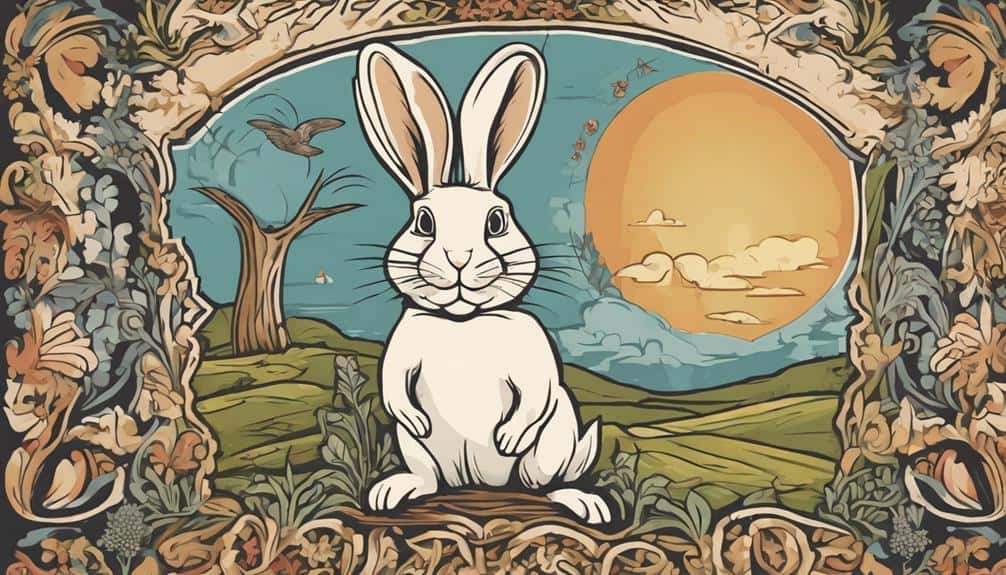
Within Christian art, the depictions of rabbits serve as poignant symbols of fertility, new life, and divine care, intricately woven into the fabric of religious iconography. These symbolic representations in Christian art hold significant meanings that resonate with believers across centuries:
- Symbolism of Fertility and Resurrection: Rabbits are often associated with Easter and the resurrection of Christ, symbolizing the cycle of new life and the hope of eternal life.
- Madonna and Child Motif: The inclusion of rabbits in depictions of the Madonna and Child symbolizes purity and innocence, emphasizing the sacred bond between mother and child.
- Connection to Saints: Saints like St. Jerome and St. John the Baptist are portrayed with rabbits, showcasing their harmony with the natural world and the care they provide to all of God's creatures.
These artistic choices not only enrich the visual storytelling of Christian narratives but also emphasize the themes of abundance, prosperity, and God's loving providence in the lives of believers.
Influence of Rabbits in Secular Art
The presence of rabbits in secular art reflects a rich tapestry of historical influences. From their introduction by the Romans for practical purposes to their symbolic depth in artistic representations over time, rabbits and hares have permeated secular art as symbols of fertility, innocence, and even trickery.
In the art world, these creatures have been featured in various forms, from paintings to sculptures, showcasing their versatility in conveying different meanings. For instance, artist Barry Flanagan's sculptures often depict playful and dynamic hare forms, challenging traditional artistic conventions and inviting viewers to explore new interpretations.
The symbolic meaning of rabbits in secular art has evolved over centuries, mirroring changes in society's perception of these animals. Today, rabbits continue to captivate artists, with their presence in contemporary art being a sign of their enduring relevance. Whether in traditional museum pieces or avant-garde installations, rabbits and hares persist as powerful symbols that enrich the artistic landscape with their timeless allure and interpretive depth.
Notable Rabbit Artworks
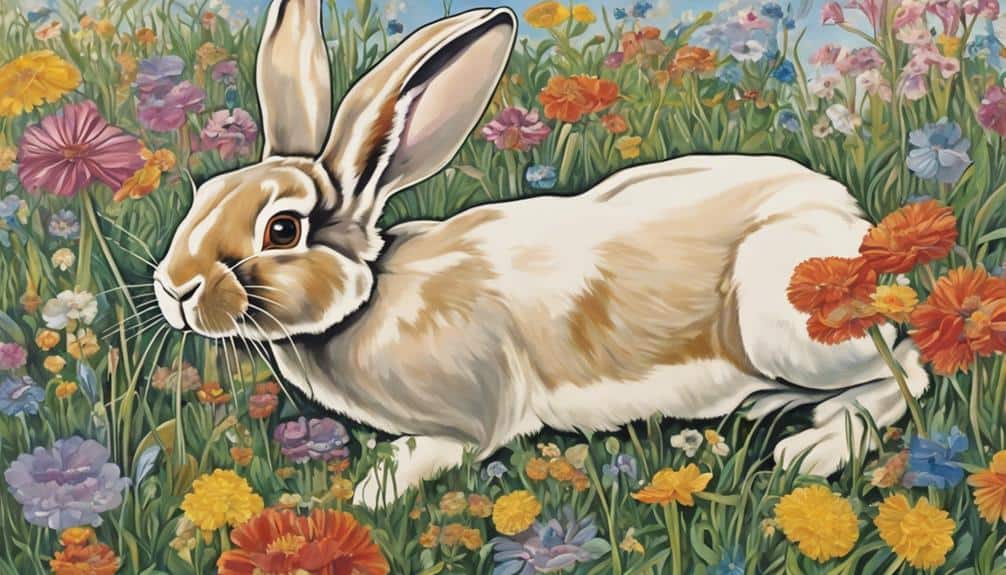
In the domain of art, notable rabbit artworks stand as intriguing examples of the enduring allure and interpretive depth these creatures bring to the canvas. Here are some significant rabbit artworks that have captured the imagination of art enthusiasts:
- Jeff Koons' Rabbit: This iconic stainless-steel sculpture by Jeff Koons fetched an astonishing $91.1 million, setting a record for the highest price paid for a living artist's work.
- Vincent van Gogh's Field with Two Rabbits: Van Gogh's masterpiece showcases his unique artistic style and interpretation of rabbits in their natural habitat, reflecting his deep connection with nature.
- Madonna and Child with Saint Catherine and a Rabbit by Clement Burlison: This artwork by the Welsh sculptor incorporates the idea of rabbits as symbolic elements within a religious theme, exploring the hare as a vehicle for conveying deeper meanings.
These artworks highlight the diverse ways in which rabbits have been portrayed in art, from being part of a set to symbolizing various themes and emotions.
Frequently Asked Questions
What Do Rabbits Symbolize in Art?
Rabbits symbolize fertility, luck, creativity, and abundance in art. They embody cultural significance, mythological connections, psychological interpretations, historical representations, and artistic expressions. Their presence invokes compassion, innocence, and the wonder of life's possibilities.
What Are Rabbits Symbolic Of?
In art, rabbits embody fertility symbolism, connect you to nature, represent innocence, reflect diverse cultural interpretations, and allude to mythological references. Their presence in art sparks contemplation, evoking a sense of wonder and possibility.
Do Rabbits Represent Creativity?
When thinking about creativity, consider the symbolic power of rabbits in art. Their presence can inspire new ideas, ignite your imagination, and fuel your artistic expression. Rabbits embody the limitless potential of creative symbolism and interpretation.
What Is the Meaning of the Rabbit Image?
As you explore the rabbit image, immerse into the layers of cultural interpretation and hidden meanings. Artists wield this symbol in their artistic representation with depth, infusing visual symbolism to convey profound insights and emotions.
Conclusion
To sum up, rabbits in art serve as more than just cute, fluffy creatures. They hold a deep historical significance, symbolizing various themes such as sexuality, purity, and paradoxical meanings.
From ancient rock paintings to modern masterpieces, rabbits have been a versatile symbol used by artists to convey complex ideas. Their enduring presence and diverse interpretations make them a powerhouse of symbolism in the art world, drawing viewers in with their magnetic charm and profound meanings.


